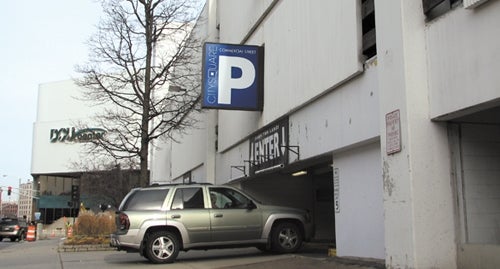When Unum Group’s massive new office building at CitySquare in downtown Worcester is built, it’ll have its own parking. Just a few blocks away, the city’s new courthouse was built without any such provision, and the same can be said for any of the Massachusetts College of Pharmacy and Health Sciences downtown developments.
Still, when the Winsor building downtown was scheduled for foreclosure auction recently, city real estate brokers speculated that the building, which is more than 30 percent vacant, suffered from a lack of parking, even though the massive Front Street parking garage is well within walking distance.
Space Constraints
For planners, government economic development officials and real estate brokers, how important parking is to economic development varies. And how important parking is to cities and towns in general, is similarly variable.
After all, people don’t visit Boston because of its ample parking. But it could be a problem getting people to visit Worcester at all without it.
Parking is expensive for almost everyone. Construction of a parking garage generally costs about $20,000 per space, estimated Jonathan Church, community development manager at the Central Massachusetts Regional Planning Commission.
To pay for the amenity, commercial tenants of buildings that include parking typically pay lease rates $3 or $4 more per square foot than others, said Jim Glickman of Glickman Kovago & Co., a Worcester-based commercial real estate firm.
By the same token, it’s an amenity that many commercial tenants can’t do without.
“From a market standpoint, it seems to be a very large issue, especially for office,” Glickman said.
“Retail is different. Look at Shrewsbury Street. There’s no parking over there, and it does well.”
Church said parking often gets far more attention than warranted.
“In some peoples’ minds, if I can’t park on the property, I don’t want to bother,” he said.
In Boston and New York, the perception is much different. Church said the CMRPC has done studies that show literally thousands of trips in Central Massachusetts taken by car every day that could have easily been made on foot or by bicycle.
Worcester does not have the type of public transit system that allows visitors, workers and residents of Boston and New York to live without parking, and often without cars at all.
Still, New England’s second largest city is stuck in a mindset that equates a building’s parking needs with its square footage.
And that mindset, once codified and enforced, becomes the expectation among tenants, employees and visitors.
Worcester is finding that requiring developers brave enough to refurbish old mills to comply with the city’s parking law, which requires two spaces for every 1,000 square feet, is simply untenable.
Industry standards that consider any parking lot or garage to be “overworked” once it’s 85 percent occupied have also outlived their usefulness.
“At some level, parking is a need for any commercial activity,” said Tim McGourthy, Worcester’s economic development director. “But that parking does not have to be on site. It has to be within walking distance, but it doesn’t have to be on top of your building, or under it in order for your business to be successful.”
Drive Time
“Parking is overplayed as an issue in downtown Worcester,” McGourthy said. “Worcester has bus lines, access to commuter rail, garages that are walkable, sidewalks, and is pedestrian friendly.”
One important consideration for any city undertaking redevelopment efforts is “wherever there’s a parking space, there’s not a person, and city vitality is measured in people, not in parking spaces.
We’ve been looking at alleviating the need for parking in order to achieve more density,” McGourthy said. “I think people realize it’s a way of unlocking the potential of these older buildings. By removing parking requirements, it allows things to move forward.”
Kevin Hively is principal at Ninigret Partners, a Boston area economic development consulting firm that’s done work in Central Massachusetts.
He says that the trick for any city or town is to strike a balance.
“At times, (parking) can play too much of a role, but you can’t underestimate its importance,” Hively said.
In Boston, there’s what Hively called “a tight density of things to do” within easy walking distance.
And those “things to do” include many options for work, dining and other activities.
“There, you just need to have enough parking, but not everybody needs parking. With a lower density (of things to do), then you need to think about parking within proximity.”
Getting Creative
But that certainly doesn’t mean that every building needs its own parking lot or garage that will never be more than 85 percent full.
Hively encourages a simple, yet much more creative approach.
In Newport and Providence, restaurants are allowed to open with no onsite parking at all, as long as the restaurant can provide valet parking.
In Louisville, Ky., downtown office buildings use publicly owned parking that is available to others after hours.
“It doubles utilization,” Hively said. If those parking lots and garages were privately owned, “they just sit there in the evening, because it’s tied to a certain employer.”
Like McGourthy, Hively said it’s time to rethink “hard and fast” parking requirements.
“You have to look at the nature of the activity that’s going on there,” he said.

